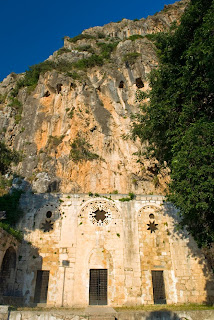St. Nicholas, also known as Santa Claus, was born in Patara and became the bishop of Demre, in Antalya. Contrary to the popular belief that Santa Claus lives in the North Pole,
he actually lived in Myra (Antalya). St. Nickholas was born to a wealthy and religious
family in Patara, where he spent most of his childhood studying the
Sacred Script in Church. After the death of his parents, St. Nicholas
dedicated his life to helping people. You can learn more about St.
Nicholas by visiting his house in Myra, which has now been converted to a
museum. You may also visit cayagzı with springs at a warm temperature
that are said to having healing minerals in them that can cure skin
disease.
Ephesus and Halicarnassus (the place for the two of the Seven Wonders of the ancient world) are in Turkey. The ancient city of Ephesus located near the Aegean Sea in modern day Turkey, was one of the great cities of the Greeks in Asia Minor and home to the Temple of Artemis,
one of the Seven Wonders of the World. Ephesus is also a sacred site for Christians due to its
association with several biblical figures, including St. Paul, St. John
the Evangelist and the Virgin Mary. Halicarnassus was an ancient Greek city at the site of modern Bodrum in Turkey. It was located in southwest Caria on a picturesque, advantageous site on the Ceramic Gulf. The city was famous for the tomb of Mausolus, the origin of the word mausoleum, built between 353 BC and 350 BC, and one of the seven wonders of the ancient world. It was part of the Persian Empire until captured by Alexander the Great at the siege of Halicarnassus in 334 BC.
The famous Trojan Wars took place in Western Turkey, around the site where the Trojan horse rests today. Troy
is a city which existed over 4.000 years and known as the center of ancient
civilizations. For many years people believed that it was the city mentioned
only in the tales
and never existed until it was first found in the 19th century. Troy is located in Hisarlik near Canakkale province where the remains of this once-great city can be visited. What was left are the remains
of the destruction of Schliemann, the famous German archaeologist or a treasure
hunter as some people call him. Today, an international team of German and
American archaeologists bring the Troy of the
Bronze Age back to life under a sponsored project by Daimler - Benz, and
another Turkish team is at law wars with Russia and Germany to get back the stolen Trojan
treasures.
The first church built by man (St. Peter’s Church) is in Antioch (Antakya), Turkey. Antioch on the Orontes (as it was called, to differentiate it from
other, lesser Antiochs) is smaller now than it was in antiquity. Founded
in the fourth century BC, it grew to be, along with Rome,
Constantinople and Alexandria, one of the most important cities of the
Roman Empire. From its peak population of nearly half a million in those
heady days of empire, the city is now home to about 200,000 people. After
the more conservative Tarsus, Antioch would have seemed to Saint Paul a
place of abundant water, beauty, life and learning. Following his
conversion, Paul preached his sermons and saved his first souls here;
Saint Peter founded a church here; and it was in Antioch that the word
"Cristianos" was first used to describe this band of believers. The
cave church of St Peter's is a 10-minute drive, then a bit of a climb
above town. It a movingly simple grotto, said to originally have been
dug by Peter himself out of the soft volcanic rock of Mount Starius: its
facade was constructed by Crusaders in 1100, and rebuilt in the 19th
century.
The First Ecumenical Council was held in Iznik, Turkey. Iznik has been described by the Christian
world as the third "holy city" after Jerusalem and the Vatican. Iznik, which is 85 km from Bursa,
having fertile
land and vast historical assets together with a beautiful lake, is known
worldwide for its tiles. It was an important city of the Roman, Byzantine,
Seljuk and Ottoman empires. The 1st and 7th
Ecumenical Councils
were held in Iznik in 325 and 787 A.D., respectively. To evaluate the potential
of the city, the Turkish Culture and Tourism Ministries decided to include
Iznik in their projects. The aims of "Faith Tourism" are to vary tourism,
to impart the image of a "secular Turkey" to the
world, and to stress the "tolerance" in Islam towards
other religions. As a result of controversies which arose because of doctrinal differences
in the Christianty in 320 A.D. the Byzantine
Emperor Constantine convened the first
Ecumenical Council in Iznik in 325. At the Council, attended by 300
bishops, a solution was sought to resolve the controversy over the divinity
of Christ. Later Empress Irene convened the 7th Council
in Iznik in 787 A.D. At the end of the 19th Council held in the Vatican in 1962, Iznik was declared a "holy city" for Christians.
The number of
species of flowers in Turkey is approximately 9,000, of which 3,000 are
endemic. In Europe for instance there are 11,500 species. This shows the
richness of flora and fauna in Anatolia. In the year 2000 about 9300 species of vascular plants were known for
the area of the Turkish Republic. The significance of this number
becomes evident if we compare it with Europe as a whole, containing
about 24% more species (about 11500), distributed over a thirteen times
larger area. The most important reasons for Turkey’s high plant biodiversity are supposed to be the relatively high proportion of endemics in combination with a high degree of climatic and edaphic variety. DAVIS & al. (1988) calculated that nearly one third or Turkish plant species (30,6%) is endemic to Turkey and the nearby Aegean Islands. For Austria the respective value is meagre 1,56% and for the British Isles it is still lower.
The oldest known human settlement is in Catalhoyuk, Turkey (7th Millenium B.C.) It was a very large Neolithic and Chalcolithic proto-city settlement in southern Anatolia,
which existed from approximately 7500 BC to 5700 BC. It is the largest
and best-preserved Neolithic site found to date. In July 2012, it was
inscribed as a UNESCO World Heritage Site.
Çatalhöyük is located overlooking the Konya Plain, southeast of the present-day city of Konya (ancient Iconium) in Turkey, approximately 140 km (87 mi) from the twin-coned volcano of Mount Hasan.























Thank you for to give the more valuable information about things that we don't have knowledge about. Their is one more website in my mind tuvanahotel.com which can also provide valuable information about Antalya Turkey.
ReplyDelete